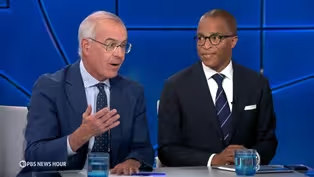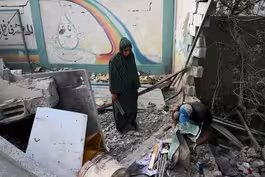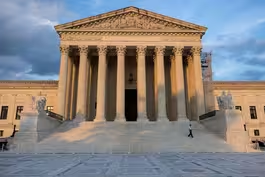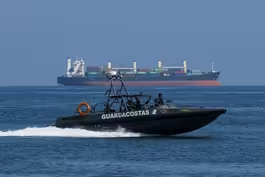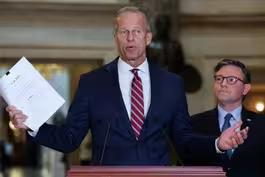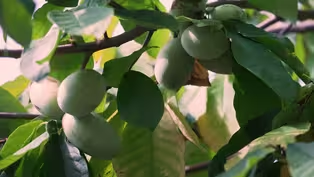
Utah art project spotlights Great Salt Lake’s fragile future
Clip: 10/3/2025 | 7m 52sVideo has Closed Captions
Utah art project spotlights Great Salt Lake’s fragile future
As the Great Salt Lake in Utah continues to dry up, the arts community has mobilized to lay bare the major ecological, economic and health stakes if the decline continues. The public art project, Wake the Great Salt Lake, aims to educate and inspire residents and visitors alike. Senior arts correspondent Jeffrey Brown reports for our arts and culture series, CANVAS.
Problems playing video? | Closed Captioning Feedback
Problems playing video? | Closed Captioning Feedback
Major corporate funding for the PBS News Hour is provided by BDO, BNSF, Consumer Cellular, American Cruise Lines, and Raymond James. Funding for the PBS NewsHour Weekend is provided by...

Utah art project spotlights Great Salt Lake’s fragile future
Clip: 10/3/2025 | 7m 52sVideo has Closed Captions
As the Great Salt Lake in Utah continues to dry up, the arts community has mobilized to lay bare the major ecological, economic and health stakes if the decline continues. The public art project, Wake the Great Salt Lake, aims to educate and inspire residents and visitors alike. Senior arts correspondent Jeffrey Brown reports for our arts and culture series, CANVAS.
Problems playing video? | Closed Captioning Feedback
How to Watch PBS News Hour
PBS News Hour is available to stream on pbs.org and the free PBS App, available on iPhone, Apple TV, Android TV, Android smartphones, Amazon Fire TV, Amazon Fire Tablet, Roku, Samsung Smart TV, and Vizio.
Providing Support for PBS.org
Learn Moreabout PBS online sponsorshipGEOFF BENNETT: As the Great Salt# Lake in Utah continues to dry up,## the arts community there has mobilized# to lay bare the major ecological,## economic and health stakes# if the decline continues.
Some have called this an environmental# nuclear bomb of toxic dust, harming## people and industries that rely on the# lake.
A public arts project called Wake## the Great Salt Lake aims to educate and# inspire residents and visitors alike.
Our senior arts correspondent, Jeffrey Brown, took# a look for our arts and culture series, Canvas.
BONNIE BAXTER, Director, Great# Salt Lake Institute: So that's## Antelope Island out ther.. JEFFREY BROWN: Uh-huh.
Uh-huh.
A summer day at the Great Salt La.. long an idyllic place to observe wildlife,# attracting locals and visitors from all## over.
But in recent years, the largest saltwater# lake in the Western Hemisphere has been ailing.
BONNIE BAXTER: We're on# the precipice.
You're very,## very close to an ecosystem that is collapsing.
JEFFREY BROWN: Biologist Bonnie Baxter is# director of the Great Salt Lake Institute## at Westminster University in Salt Lake# City.
She says excessive water diversion## for agriculture and cities and a long-term# megadrought exacerbated by climate change and## reduced precipitation have created a crisis, in# which public health is being threatened by toxic## dust from the flat dry lake bed, or playa,# containing arsenic and other heavy meddles.
BONNIE BAXTER: We're next# to a metropolitan center,## and the public health dangers of breathing# this playa dust is terrible.
So as we expose## these shorelines, the dust can become# airborne and really impact the air quality.
JEFFREY BROWN: And the# ecosystem hangs in the balance.
BONNIE BAXTER: We have worked to balance the# salinity to help the life in the lake that## feeds all of the birds survive.
Ten million birds# depend on this ecosystem.
It's so important that## it's probably the most important body# of water on the whole Pacific Flyway.
JEFFREY BROWN: Enter the Wake the Great# Salt Lake public art challenge, a project## to raise public awareness and perhaps mobilize a# response through art placed throughout the city;## 125 applications were culled to 12# multidisciplinary projects, as well as## events and workshops, with scientists including# Baxter consulting with artists along the way.
Felicia Baca is executive director# of the Salt Lake City Arts Council,## part government agency, part nonprofit.
FELICIA BACA, Executive Director, Salt# Lake City Arts Council: We believe that## the arts are a universal language and that can# provide acce.. It's a language that is approachable# for many residents where data and## science may not be.
And while the project is# founded in data and science and education,## we really think that arts# create an emotional connection.
And they're a place for, like, unity# and coming together and gathering.## And those are the kind of conditions in# which you build and engage citizenry.
JEFFREY BROWN: That engagement included dance... MAN: The novelty, the# excitement of a new environment.
JEFFREY BROWN: ... a museum# exhibit, Vanishing Waters,## Rising Voices, an installation, By a# Thread, inside the Utah State Capitol,## and a pop-up water school structure# for all to see, learn, and engage with.
TREVOR DAHL, Muralist: Let's do# that, but I want to like draw it in.
JEFFREY BROWN: Building an engaged# citizenry is just what muralist Trevor## Dahl was after when he launched his art# activation after consulting scientists## and Native American community leaders# about the delicate balance of the lake.
TREVOR DAHL: Some depictions of# these creatures that are lovable.
And## so whether you get the message about the# mural or anything, you can kind of say,## like, oh, those brine shrimp are so cute,# or, like, just a way to anthropomorphize## the lake a little bit.
We start to care# about it.
We start to demand that our## representatives care about it.
They start to# hold industry accountable.
And that's the idea.
JEFFREY BROWN: I mean, a mural in a small# parking lot by itself doesn't do anything.
TREVOR DAHL: Yes.
JEFFREY BROWN: But it's th.. TREVOR DAHL: Right.
It's part of a wave.
And we're# all, as artists, doing our best to help th.. JEFFREY BROWN: Across town at Spy Hop,# an after-school youth media art center,## students designed and printed digital zines,## handmade and self-published, a way to reach# and teach others about the ongoing crisis.
Recent high school grads Josie Callahan# and Eddie Memmott spoke of the personal## stakes for themselves and for a lake# that's a commercial source of magnesium,## lithium, and other mineral compounds.
EDDIE MEMMOTT, Student: It affects our food.# It affects our phones.
It affects our air.
It## affects our water.
And it affects our bills.
When# I learn about things and start caring about them,## the biggest factor is usually how# it affects me and the people I love.
So I thought talking about how this does# matter and it will affect you and it## will change your life, you should# care, felt very important to me.
JOSIE CALLAHAN, Student: My own personal# experience of, like, sort of climate and## environmental anxiety, I was like I need to have# something that can be sort of convenient, right?
JEFFREY BROWN: Very specific.
What can one do?
JOSIE CALLAHAN: What can we do,# right.
Not everyone is aware of## the people who are kind of taking the# most advantage of our water usage.
JEFFREY BROWN: An installation titled Hopeline# was reaching the public in perhaps the most## interactive way of any work in the project# through a pop-up old phone booth in which## passersby could hear the sounds of the lake's# birds and waves and stories left by others.
WOMAN: You know, you're the last yard of the# ocean here.
And since I grew up by the ocean,## it feels like a glimpse of# home every time I see you.
JEFFREY BROWN: While also leaving their# own stories.
Three artists behind Hopeline,## friends who grew up together in Salt Lake City,# say the problem, including regular dust storms,## is so acute they're considering leaving# their hometown, a place they love.
NICK CARPENTER, Artist: I think The New York Times# put it as like an environmental nuclear bomb.
JEFFREY BROWN: But that's how you feel.
NICK CARPENTER: At times.
And I think you're# reminded of it when you do see these dust## storms coming into town that maybe it's not# worth potentially buying real estate here.
JEFFREY BROWN: Yes.
You mean like you# might have to leave at some point?
HAN CALDER, Artist: Definitely.
JEFFREY BROWN: Still, for this project,## they decided to offer a sense of hope.
And that's what they heard from others.
HAN CALDER: Well, I think a lot# of people will bring love into it,## right?
And maybe that has hope in it.
If# you love something, there's hope for it,## right?
So a lot of people will just say like,# I love you, Great Salt Lake.
And that has## been really endearing to me just to hear so# many people say I love you, Great Salt Lake.
JEFFREY BROWN: What does it all add up to?# Scientist Bonnie Baxter: continues to push## for public policy changes.
But she's also a firm# believer that art and artists have a role to play.
BONNIE BAXTER: Scientists can communicate# to the public, but maybe we don't get the## attention of everybody, right?
And so# to have artists at the table to help## express this crisis in a more visceral# way, people wake up and they listen.
JEFFREY BROWN: For the "PBS News Hour," I'm# Jeffrey Brown at the Great Salt Lake in Utah.
Brooks and Capehart on shutdown and political dysfunction
Video has Closed Captions
Clip: 10/3/2025 | 12m 43s | Brooks and Capehart on political dysfunction and the government shutdown (12m 43s)
Hamas responds to Trump's Gaza peace proposal
Video has Closed Captions
Clip: 10/3/2025 | 4m 52s | Trump demands Israel end Gaza attack as Hamas responds to his peace proposal (4m 52s)
A look at cases the Supreme Court will take up in its term
Video has Closed Captions
Clip: 10/3/2025 | 8m 16s | A look at the major cases the Supreme Court will take up in its new term (8m 16s)
News Wrap: U.S. forces destroy another boat near Venezuela
Video has Closed Captions
Clip: 10/3/2025 | 4m 40s | News Wrap: U.S. forces destroy another suspected drug boat near Venezuela (4m 40s)
No end in sight for shutdown as Congress leaves for weekend
Video has Closed Captions
Clip: 10/3/2025 | 3m 13s | No end in sight for shutdown as Congress leaves for weekend (3m 13s)
The pawpaw: America's forgotten fruit finds new popularity
Video has Closed Captions
Clip: 10/3/2025 | 4m 40s | The pawpaw: America's forgotten native fruit finds new popularity (4m 40s)
Shutdown puts further strain on air traffic control system
Video has Closed Captions
Clip: 10/3/2025 | 5m 9s | Shutdown puts further strain on already understaffed air traffic control system (5m 9s)
Providing Support for PBS.org
Learn Moreabout PBS online sponsorship
- News and Public Affairs

FRONTLINE is investigative journalism that questions, explains and changes our world.

- News and Public Affairs

Amanpour and Company features conversations with leaders and decision makers.












Support for PBS provided by:
Major corporate funding for the PBS News Hour is provided by BDO, BNSF, Consumer Cellular, American Cruise Lines, and Raymond James. Funding for the PBS NewsHour Weekend is provided by...
